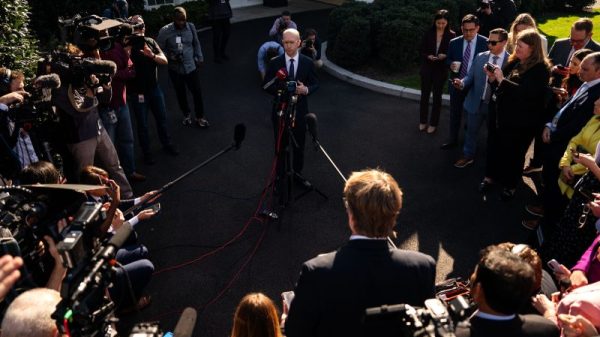The decision to conduct a controlled burn of five derailed tank cars that unleashed a plume of toxic chemicals last year in East Palestine, Ohio, was based on flawed and incomplete information, the chair of the National Transportation Safety Board testified Wednesday at a Senate hearing.
Jennifer Homendy, facing questioning from Sen. J.D. Vance (R-Ohio), testified that contractors employed by the Norfolk Southern railway company “lacked the scientific background” to decide that a vent-and-burn was necessary to head off a chemical reaction that could cause the cars to explode. She testified that a better option would have been to allow the tank cars time to cool down.
The testimony follows the NTSB’s release over the past year of a trove of documents that have called into question the February 2023 vent-and-burn, which spurred an extensive cleanup operation and health concerns among residents of the small Ohio town.
As part of its ongoing investigation, the NTSB has disclosed that Gov. Mike DeWine (R), Fire Chief Keith Drabick and other officials were told they had just 13 minutes to decide whether to vent the vinyl chloride-carrying cars or wait and risk a likely uncontrolled and catastrophic explosion.
Drabick, the East Palestine incident commander who later testified he was “blindsided” by the rushed timeline, gave his go-ahead for the company to conduct the vent-and-burn.
“They were provided incomplete information to make a decision,” Homendy said Wednesday. “There was another option: let it cool down.”
Homendy also said that experts from the OxyVinyls chemical shipping company informed Norfolk Southern’s contractors that they didn’t believe the chemical reaction was taking place or could take place, but that they were not included in the meeting where the decision to do the vent-and-burn was made. “They were not given full information because no one was told OxyVinyls was on scene,” she said. “They were left out of the room.”
After the hearing, Vance said her testimony raised questions about whether the railway company or its contractors were recommending the vent-and-burn to “facilitate the rapid movement of freight,” given that trains were able to pass again soon after the burn. He said his questioning was not intended as a critique of DeWine or Drabick, but rather was meant to reveal whether the decision-makers that day lacked complete information.
DeWine, in an interview with The Washington Post before the hearing, said he had no reason to believe there were other viable options available to head off an explosion, given that none of the officials in charge were informed of that possibility at the time.
“You have to go with the facts you have at the time,” DeWine said. “I’m in no position to judge the merit of what these people are now saying, but what I can tell you is that they had plenty of opportunity to raise their hand and come up with a different scenario and different options, and nobody did.”
The decision to burn off the chemicals has faced scrutiny since just days after it happened. Pennsylvania Gov. Josh Shapiro (D) wrote to Norfolk Southern President Alan Shaw that very month that the railway “failed to explore all potential courses of action, including some that may have kept the rail line closed longer but could have resulted in a safer overall approach for first responders, residents and the environment.”
Norfolk Southern and its contractors have denied the allegation, saying that the only way to keep people safe was to do the vent-and-burn.
In a statement, a spokesman for Norfolk Southern said the final decision to do the vent-and-burn was made by the incident commander, and he defended that course of action. “The successful controlled release prevented a potentially catastrophic uncontrolled explosion that could have caused significant damage for the community,” the spokesman said. “To date, continuous environmental testing in coordination with and alongside U.S. and Ohio EPA has shown the air and drinking water in the community are safe.”
After the train derailed on Feb. 3, 2023, Norfolk Southern relied on two contractors on the scene that specialized in transferring hazardous chemicals and industrial firefighting: Specialized Professional Services Inc. (SPSI) and Specialized Response Solutions (SRS).
The SPSI contractors said they believed that the fires around the cars had probably triggered a chemical reaction, called polymerization, that could lead to a catastrophic explosion of the tank cars. SRS officials were also concerned that the reaction was occurring in one car. They recommended a vent-and-burn to minimize risks to personnel should the car explode on its own.
The contractors ruled out other options to get rid of the materials — including transferring the product, drilling into the tanks to relieve the pressure, or re-railing the tank cars with the chemicals still on board. They said those measures posed too great a risk to first responders.
But the tank car displaying high temperatures had begun cooling down and stabilizing before the vent-and-burn occurred, which Hamendy said showed that the first responders could have waited and seen if the car continued to cool down and could then be disposed of in a less destructive manner. (One of the five tank cars had shown an elevated exterior temperature that climbed to a peak of about 140 degrees Fahrenheit before dropping to the mid-120s.) Vent-and-burn involves puncturing the tank car at two points and then burning off the materials as they leak out.
“Based on what we were seeing — excessive heat, high temperatures, unable to get good pressures on the cars — we had to make a judgment call that a reaction, a polymerization potential was extremely elevated,” said one SRS official, according to the NTSB report.
Officials with OxyVinyls, a company that was shipping the chemicals and is being sued by Norfolk Southern to help pay for the disaster, said they repeatedly expressed to Norfolk Southern’s contractors that they did not think polymerization was taking place. OxyVinyl’s technical manager told the SPSI president that OxyVinyls “did not see any obvious signs that polymerization was occurring within the tank cars,” given that the temperatures of the cars would be higher if that was the case.
“If the vent and burn option was pursued, the technical manager expressed concern to SPSI about the potential for a vapor cloud explosion, and the major combustion byproduct being toxic and corrosive hydrogen chloride,” the report said.
On Feb. 6, 2023, the contractors told a meeting at East Palestine High School involving DeWine, Shapiro via phone, and many other local officials and first responders that a vent-and-burn would be the best option because of the high risk that the car could explode by itself. They also argued that all five cars must be vented and burned because venting only one or two cars could raise the risk that the other cars would increase in pressure.
After that meeting, a smaller group including DeWine and the incident commander were asked to join Norfolk Southern in a separate room. The SPSI president and the SRS project manager told DeWine he had only 13 minutes to decide if he would allow the vent-and-burn to proceed because they needed to conduct the operation before sunset. The incident commander asked them to explain the vent-and-burn one more time, then gave his go-ahead to the team, believing it was the only way to avoid a catastrophic explosion, the NTSB report said. The incident commander said he had received no conflicting information that it was possible the tank cars were not going to explode.
Federal guidelines on vent-and-burns say they should be used only as a last resort, when all other methods of transferring the materials have been exhausted.
In the interview, DeWine said the discussion on the right course of action had gone on for hours before they were informed that sunset was nearing and the decision had to be made very quickly. He dismissed the 13-minute window as giving a misleading impression that they discussed the scenario for only a short time.
“If there were experts on the scene that day who knew all this information, they did not get that information to the people making the decisions,” DeWine said.
The hearing occurred as the Senate still awaits a vote on railway safety legislation championed by Vance and Sen. Sherrod Brown (D-Ohio).




























